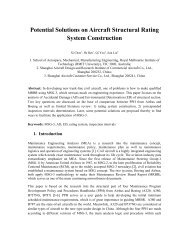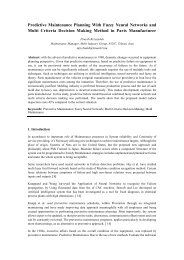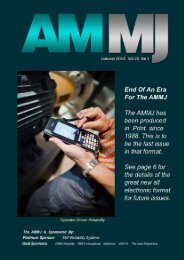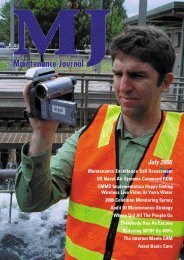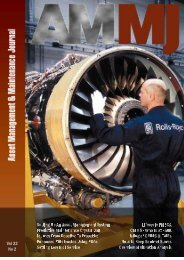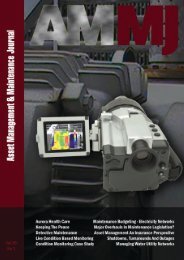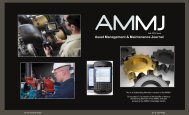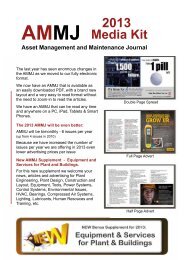July - AMMJ
July - AMMJ
July - AMMJ
Create successful ePaper yourself
Turn your PDF publications into a flip-book with our unique Google optimized e-Paper software.
<strong>AMMJ</strong><br />
Maintenance Decision Support Project 34<br />
The most basic data requirement, therefore, of reliability analysis (Weibull, PHM, and most others) is to distinguish<br />
between failure and suspension when reporting the as-found condition of each significant failure mode encountered<br />
during the execution of a work order.<br />
In any reliability study the working age of the equipment is important. Working age is a reference line measuring the<br />
accumulated usage of, or stress on, a component. The engineering units selected for working age should reflect the<br />
accumulated normal wear and tear on the component. Calendar age is appropriate when the equipment operates<br />
more or less uniformly. Energy consumed or production units delivered often provide a better indication of true<br />
working age. Pump operating hours were not easily available and had to be estimated based on the date of the work<br />
order and known operating practices for the pumps. For example, the two catholyte pumps shared the same duty<br />
and swapped from online to standby every two weeks. Knowing this, the working age could be estimated based on<br />
calendar dates, average plant uptime, and 50% run time. The other two pumps ran continuously and the working life<br />
was based directly on the work order’s date.<br />
Vibration data<br />
Condition monitoring (CM) on site has been used for over 9 years. This includes vibration analysis (VA) of all pump<br />
sets, fans and compressors. The CM is conducted by a specialist external contractor. Critical drives that have standby<br />
redundancy are changed over regularly to ensure that they still run. Standby units are started up to perform VA. The<br />
VA data is compiled by the Contractor and an executive summary forwarded to Laverton each fortnight.<br />
The VA report attributes to each of the rotating machines a performance rating of “1” to “5”. When machines reach<br />
level 3 we begin to monitor closely, at level 4 we plan to replace at next opportunity and if level 5 we would replace<br />
immediately. No “scoreboard” is kept to tally hits, misses, and false alarms by this condition monitoring program.<br />
(Doing so, in a “Living RCM” N4<br />
project, is an important conclusion of this study.)<br />
If the VA reported equipment condition is so severe and a decision to replace is made, it will have significant production<br />
impact. An example is a magnetic drive pump motor on the Catholyte system that was exhibiting excessive noise. A<br />
decision was made to replace the motor rather than risk an unplanned trip (potentially occurring only hours later).<br />
When faced with a decision to shutdown and replace an item the level of confidence in making that decision is, for the<br />
aforementioned reasons, not known. Some pumps have been known to run for extended periods at high vibration<br />
levels without the need for replacement. This implies that factors, others than those reported by VA, influence failure<br />
probability. It is incumbent then, upon the organization and its reliability engineers, to identify, through observation<br />
and analysis, those internal and external factors likely to influence production and profitability.<br />
Operational History<br />
Another source of information was obtained from the plant Distributed Control System (DCS) alarm history logs. This<br />
source of data assisted with confirming pump working ages by flagging stop and start events.<br />
DATA CLEANSING & TRANSFORMATION<br />
Data Cleansing<br />
Before using reliability analysis software a number of steps are required to cleanse and transform the data.<br />
1) Prepare or update the FMEA for pump and motor. The FMEA constitutes a “knowledge base” each record<br />
of which describes a failure mode whose behavior is to be determined by the “counting up” (i.e. basic reliability<br />
analysis) of the work order instances of that failure mode.<br />
2) Identify the failure modes from the work orders and link them to the FMEA. Each link represents an ending<br />
and beginning event in the sample.<br />
3) Correlate VA data to the pump failure and suspension events using a technique such as PHM.<br />
4) Ensure that any PM activities are properly allocated to either suspension or failure events of the pumps.<br />
5) Use the DCS recorded stop/start events, if necessary, to determine pump working age at each life event (i.e.<br />
work order).<br />
6) Before modelling use the data validation function in the software to locate, repair or eliminate erroneous and<br />
illogical data. A common example of the latter would be an Event or Inspection record containing a working<br />
age at a later date that is lower than a working age at an earlier date.<br />
7) Create beginning events where life cycles began prior to start date of the sample window.<br />
8) Ensure that failures and suspensions are accurately identified and distinguished. Confirmed “potential”<br />
failures should be counted as failures. Well discussed maintenance department standards should distinguish<br />
failures from suspensions.<br />
Surprisingly, Failure Mode Effects Analysis (FMEA) for the basic magnetic pump and even the standard induction<br />
motor were difficult to find in public sources. Many references to the method are available however no specific<br />
analysis could be found. The study developed a FMEA model (by mining the work order history) for the pumps and<br />
Vol 24 No 3




